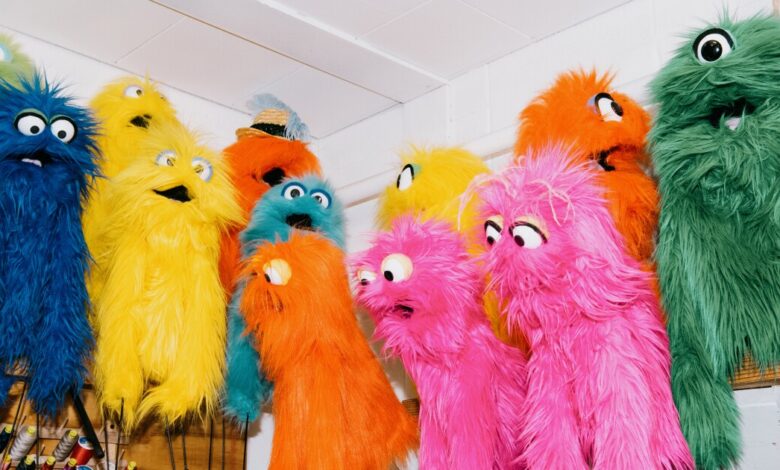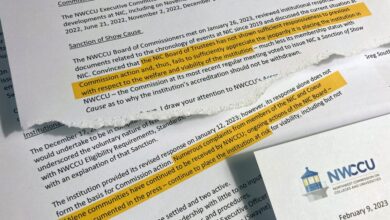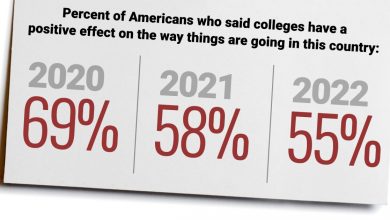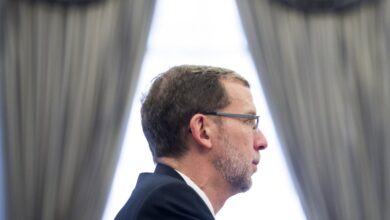Is College for Puppets?

It’d take months to see if her effort paid off. Maybe they’d survive. Maybe they’d even grow.
McClung, a professor and director of costuming at West Virginia University, also sees value in the inanimate. Cluttering her office are blocks of foam, sheets of tissue paper, bubble wrap, takeout containers, a bag of plastic party cups, and a small balloon that reads “Thank You.” It’s junk, but she might find a use for it. “I’m not a hoarder,” McClung said. “I know it seems a little questionable. But there’s a purpose!”
One purpose is puppets. That foam can be carved into a puppet nose and bolted to a puppet face. Christmas ornaments, split in half, make perfect puppet eyeballs.
McClung effectively runs West Virginia University’s bachelor of fine arts in puppetry. It’s a near-unique program that houses a small cohort of undergraduates who relish the chance to spend school time honing their niche craft.
Even so, the puppetry program is in danger. Two years ago, the number of students hovered near zero, and the major was nearly eliminated. It was spared after promising to attract more students. Now an impending round of program cuts threatens its future once again.
Teaching puppetry in college defies a certain logic. Financial imperatives tend to push universities to increase enrollment and emphasize career training. That’s especially true at West Virginia, a land-grant institution that’s bleeding students in an economically struggling state. Here in Morgantown, those pressures are bearing down, and the university is making tough choices about what to keep. An obscure major that does not fill lecture halls or prepare students for local industry might not be worthy of a life raft.
But there’s another argument to consider: that universities are supposed to be places where esoteric disciplines persist — where students can pursue unusual passions and learn things that don’t just prepare them for the work force but enrich their lives. Maybe even a place for fun.
What in a university is worth preserving? Your answer depends on which argument you believe. To McClung and others, puppetry is like the block of foam — full of value that’s easily overlooked. West Virginia may soon dispose of it.
Yet Plato also relied on puppets as a metaphor for the human condition. Also in Laws, he posits that every living creature is “an ingenious puppet of the gods” created to be “a toy of theirs” or perhaps “for some serious purpose.”
Puppetry, as the philosopher’s attitude suggests, is built on paradox. Toys taken seriously. Wooden faces that convey emotion. Dead things that are made alive. And crucially, an omnipresent art form that is also marginalized.
For thousands of years, across continents and civilizations, puppetry has lent a dose of reality to religious ceremonies, creativity to community gatherings, and catharsis to those who want to forget the actual and conjure the fanciful. In Indonesia, wayang kulit, or shadow-puppet shows, would stretch from night until dawn, illuminated by oil lamps. In Japan’s Bunraku theater, which originated in the 17th century, apprentices toiled for 10 years to master manipulating just the feet of dignified puppets.
Yet in the West, puppet theater has often been considered low culture. The craft is frequently thought of as “debased, unsophisticated, unliterary,” writes the Shakespeare scholar Kenneth Gross in his book-length love letter to the art form, Puppet: An Essay on Uncanny Life.
That’s particularly true in America where puppetry is largely perceived as for children, thanks to the popularity of shows like Mister Rogers’ Neighborhood, Sesame Street, and Fraggle Rock. That perception has staying power, even in the midst of a multidecade renaissance. The Lion King and its dazzling animal puppets became the highest-grossing Broadway musical of all time. The internet erupted when it first saw Baby Yoda, who is brought to life in the television series The Mandalorian, in part, by a puppet. (Werner Herzog, a German director who plays a minor character in the series, was reportedly so taken by Baby Yoda that when the crew prepared to shoot a scene without the puppet actor, in case it had to be replaced by a digital version, Herzog called the producers cowards. “Leave it,” he ordered.)
Puppetry abounds. And yet it remains peripheral. Puppet theater has “never fully established a fixed role for itself in contemporary American society,” writes John Bell, a prolific puppet scholar, in his 2000 book Strings, Hands, Shadows: A Modern Puppet History. It “has had to constantly reinvent itself in order to survive.”

Kristian Thacker for The Chronicle
McClung, a co-instructor, and nine students stride around a large room lined with vanity mirrors, shaking out their limbs, warming up their joints.
It’s a Monday morning in April, and today’s class on puppetry manipulation has just begun. The co-instructor, another professor named Irene Alby, coaches the students through physical exercises. Imagine your elbows and wrists are attached to strings, Alby tells them. They raise their arms over their heads. Then, Alby says, release those strings. They collapse forward at the waist and hang limply, like snipped marionettes.
Alby guides the students through cat-cow stretches (some meow, some moo) into downward-dog push-ups. They struggle through a set of 25 and retreat to the child’s pose. A couple students complain of soreness, letting out grunts and grumbles.
“All that puppetizing, you know?” McClung says cheerfully, from the ground.
Today the students are practicing short scenes with characters they will perform for Puppet Palooza, a variety show that doubles as the course’s final exam. One by one, the students approach the stage — a black cloth draped over a table — to present their work. McClung and Alby preside as hosts.
WVU is just one of two puppetry-degree programs in the country. “Isn’t that something special that we should guard and cherish?”
First up is Brandon Saghy, a music-education major. Over the table, he dangles King Alvarez IV, a marionette wearing a purple robe and a sparkly crown, who speaks in a high-pitched trill, punctuated with giggles. He has traveled to America to find his “dream girl,” and even worked with a flirtation coach. He offers to demonstrate what he’s learned.
The puppet swaggers around the stage, waggling his hips and gyrating in Alby’s direction.
“Oh lady, I’ll warm you up any night,” King Alvarez IV offers.
Things, already silly, get sillier. One student’s marionette is a pot-loving chill bro from Portland, Ore., named Pickle. A sophomore named Perry Jimenez showcases Hector El Mano — just his hand attached to a couple of ping-pong eyeballs and a mini sombrero — who speak-sings a ditty about tacos: “Tacos in the night / I am so hungry I wake up to take a mighty big bite.”
Another student, Talon Schultz, introduces a solemn-looking teddy bear wearing red, white, and blue swim trunks named Buttons McShane. In 1982, McShane says, he had been the leader of the Scottish mafia. One day he was “walking around being a dictator” when all of a sudden, his enemies ambushed him. He was rushed to the hospital where “unfortunately they had to give me blood, and that blood infused with my brain,” which caused him to develop a split personality.
“From the gunshot, I still got shrapnel in me arse,” says McShane, Shultz shaking the teddy bear, which makes a jingling noise. It gets a laugh.
At the end of class, Alby and McClung give feedback, in preparation for Puppet Palooza. They encourage the student puppeteers to embrace the absurd. “The most fun,” Alby says, “is when you tell us something and then you give us something that’s so crazy about it, or so opposite to what we expect, that we’re like, ‘What?!’ So look for those twists and turns.”
This is not a typical college class. It’s goofy! A mafioso Scottish teddy bear! But students say they’re learning lessons that transcend the surreal. Eliza Doll, a freshman studying musical theater who uses they/them pronouns, said the course has taught them how to think on their feet, and how to work with other people.
Jimenez, a puppetry major, said he loves performing, which he’s gotten to do a lot this semester. He and other puppetry students have gone on trips in the Puppet Mobile, a colorful van decorated with grinning puppets, to perform fairy tales and fables for school kids. This semester they’ve traveled, among other places, to Hamlin, a town of 1,040 people that’s about 190 miles southwest of the university, and to Pickens, where the population is in the dozens.
Puppets have been a fixation for Jimenez since childhood. But his interest sometimes isolated him. Some classmates viewed him as “the weird kid” because he’d bring puppets to high school. They would point out that his mouth moved while operating the puppet, not understanding or appreciating the difference between puppet performance and ventriloquism.
Jimenez had assumed it wasn’t possible to major in puppetry. When he found out he could at WVU, it was “a miracle.” Since then, he’s found community with his fellow “felt enthusiasts.”
“We puppet people gotta stick together,” he said.
Emma and Brianna Link, sisters from East Liverpool, Ohio, sought out WVU specifically for its puppetry program. “I’ve always liked the idea of performing,” said Brianna, the older sibling. “But it’s like, I can’t play guitar. I don’t really know about putting myself up there as an actor.” With puppetry, though, “I can do a silly little voice, and I don’t have to worry about being taken so seriously.”
Emma leans toward construction over performance. She’s quiet and has always struggled with anxiety. Puppetry allows her to set aside that part of herself and nurture her creativity. “There’s not so much worry about, like, being judged when it’s not me that people are focusing on. It’s the puppet,” she said.
She’s had skeptical family members ask what she plans to do with her major. They don’t get it. “Puppetry is part of, really, everything.”

Kristian Thacker for The Chronicle
In December 2020, Gee, the university’s president, took stock of the challenges facing his institution: a loss of public trust in higher ed, an unappealing narrative about the cost of college and student debt, a declining student population and tough competition for those students, not to mention dwindling state funding and the pandemic.
“These are perilous times,” Gee told the Board of Governors at a meeting, according to its minutes. What would get the university through them?
Focusing on “market-driven majors,” Gee said. The university needed to be “highly relevant” to students and their families. To do otherwise would limit the number of students the WVU can attract.
The university must also evaluate “every aspect” of its operation as cost-effective, driving enrollment, meeting a university priority, or otherwise having an impact on the state, or risk quickly falling behind, warned a top administrator at the meeting.
WVU embarked on what it called an Academic Transformation, led by Maryanne Reed, the provost. The effort had many lofty goals, among them providing a “rigorous and relevant education,” increasing enrollment, and strengthening the university’s position as an R1 research powerhouse. One major prong was to evaluate the “health” of the university’s academic programs — which could grow and which needed to go.
To make a diagnosis, Reed relied on data. In the spring of 2021, her team collected what it called “gold standard” criteria, mainly enrollment figures and retention and graduation rates for many of the main campus’s academic majors and degrees. By looking at those numbers, they identified “programs of opportunity” that showed enrollment growth potential and “programs of concern” that essentially showed the opposite. Cybersecurity and forensic biology were among the former. Puppetry was among the latter.
“Honestly, we love puppetry. Who doesn’t? It’s a wonderful program,” Reed told me in her office in March. But at the time of the analysis, “they had two students in the major. And, you know, it was a little hard to justify to our governing board a major that has two students. I mean, on paper, it looks really bad.” (The school’s enrollment figures show the major had three students in the 2020–21 academic year.)
“You have people outside of the university who, when you share that, are horrified. Right?” said Reed.

Duncan Slade, The Daily Athenaeum
After consulting with college deans and “getting additional context that we might have missed,” Reed said, her office issued verdicts in September 2021 for the 35 undergraduate majors and terminal master’s degrees that had been flagged, many of them in the creative or liberal arts. Some, like the B.F.A.s in ceramics, printmaking, and sculpture, should be consolidated under a single major, the office concluded. Some, like the B.A. in women’s and gender studies, should stick around but develop a plan to improve. And some, like the B.A. in religious studies, should be discontinued.
The puppetry major, too, was on the elimination list. The School of Theatre and Dance could explore making the subject into an area of emphasis, read the recommendation letter from Reed’s office.
Targeted programs were given the option to appeal. Puppetry was one of two that did.
Plus, he believed in the value of the major. It keeps the craft alive, provides a public service through its shows, and helps the school stand out in a competitive recruitment market. And no faculty or staff lines are solely devoted to it, he said, so it’s not like eliminating the program would save the university that much money. (Reed told me that the program doesn’t cost a lot, but because it requires teaching time, “it costs something.”)
Williamson appealed the decision with the backing of his dean, and took a puppet with him to the committee hearing. (“How can you say no to a puppet?” he reasoned.)
The appeal was granted. (The other program that made a case for its survival, a master of arts in Spanish, was denied.) Puppetry was essentially put on probation: It would create an improvement plan that included “key metric targets.”
It’d be evaluated again in 2023, at which point “further action may be recommended.”

Kristian Thacker for The Chronicle
According to the program’s improvement plan, which Williamson submitted to the provost’s office in 2022, it aims to reach and sustain around a dozen majors over the next several years. To achieve that goal, recruiting would be paramount.
A high-school thespian festival the university hosted this spring was a golden opportunity. A crowd of 625 teenagers packed into the College of Creative Arts building to attend workshops such as “Clowning,” “Can I Eat it? Prop Food,” and “Making Wood Look Like Wood.”
I immodestly believe that puppetry is the center point of virtually every human creative endeavor.
In a session called “Using a TV Monitor for Puppet Performance,” five students grabbed sets of ping-pong eyeballs to transform their hands into puppets before Sarah Bourne, the costume-shop manager, who has a background in puppetry, led them through a few drills. Facing a laptop, she touched her finger to the Zoom video screen while five puppet hands attempted to follow the point of focus like spectators watching a tennis match. Later, Bourne instructed the students on how to make a puppet breathe.
“If a puppet is not breathing, what is the puppet?” she asked.
“Dead,” a few students answered, correctly.
Then students improvised puppet lip syncs. “Do I have to go to WVU to be a puppet major now?” one teenager joked to another as they queued up a song from SpongeBob SquarePants. The two students’ puppet hands mouthed along to the lyrics: “Forgive me for making you wanna roam / And now my heart is beating like the saddest metronome.”
“That was so funny,” they said to each other when the song ends.
Throughout the workshop, the teenagers oozed with delight. A ninth grader exclaimed, unprompted, “I love this! I never want to leave!”
Germ Emmer (Germ, says Emmer, “like the things that spread”), a high-school junior, traveled about three-and-a-half hours to the festival. Emmer, who wore black fingerless gloves decorated with skeleton hands and a black T-shirt that bore a skeleton rib cage, has loved puppets from a young age. Recently they built two hand puppets of the children’s book characters Frog and Toad, which were on display in the college’s lobby as part of the competition portion of the festival.
Though they have a knack for puppetry, and theater is “one of my biggest passions,” Emmer plans to study something else in college: mortuary sciences. Emmer’s mother died when they were very young, and they want to make death a less-taboo topic. “If people were more involved and educated about it,” Emmer said, “they wouldn’t be as scared.”
Loving something doesn’t mean wanting to major in it, and the puppetry program needs majors. “Everybody is trying to find students now,” McClung said. West Virginia University is competing with lots of colleges for a diminishing pool of high-school seniors. Big-name institutions like New York University won’t have enrollment problems, Williamson said. “But the rest of us have to do stuff to hustle a little harder.”
Williamson’s school is hustling. That partnership with the technical entertainment company “never fully materialized,” he said. But since the fall of 2021, the school has ramped up its puppetry recruitment by promoting the major at conferences and getting the Puppet Mobile back on the road. Bourne asked puppetry groups — the Puppetry in Education and Therapy Committee of Puppeteers of America, the National Capital Puppetry Guild, Twin Cities Puppeteers — to spread the message that WVU needs puppetry-focused high-school students. Jackson Berhow, a graduate student who helps run the puppetry program, took two students in the Puppet Mobile for “West Virginia University Day” at the state Capitol to promote the major.
But recruiting is not a science, and students change their minds. McClung said she was once talking with a student who wanted to transfer to WVU to study puppetry. The student seemed driven and enthusiastic. She sent transcripts, and they talked on Zoom. “We all thought she was on board, and then she just disappeared,” McClung said. “It’s nutty.”
McClung sees students’ potential and focuses on helping them realize it. She encourages students to tell her when they’re confused, and gets frustrated when they don’t want any feedback. “Because why be here?” She can be hard on them. “I get disappointed a lot.”
As she said on another occasion: “You want everybody to be on fire for things.”
McClung is on fire for puppets, though it took her some time to find them. Growing up in Barbour County, W.Va., she gravitated to drawing. In college, she studied fine arts, first painting and then ceramics. She started sculpting pieces that had teeth and eyes. But she wanted things to feel more alive, more kinetic. She wanted them to talk.
Then, at a museum exhibit of Jim Henson’s puppet creations, things clicked into place. She saw a Skeksis, a grotesque bird-reptile hybrid from the 1982 film The Dark Crystal. The creature’s artistry spoke to something inside her. “This is what I want to do,” she thought.

Kristian Thacker for The Chronicle
After finishing her ceramics degree at Alfred University, she enrolled in graduate school at West Virginia University to pursue puppetry. WVU does not offer a master’s degree in the subject, but McClung learned the art from Joann Siegrist, the professor who’d been teaching puppetry courses since the 1970s, while getting an M.F.A. in costume design. After a career teaching and designing elsewhere, McClung returned to WVU in 2007, as a visiting assistant professor. Soon enough, she became the costuming director.
In 2015, Siegrist retired, leaving McClung as the university’s authority on puppets. The puppetry program might have died then and there. McClung even told several students who wanted to major in puppetry not to. But eventually she decided she didn’t want it to die, and grabbed the reins. Why?
WVU is just one of two puppetry-degree programs in the country, McClung says one day in the puppet shop, a cluttered workroom where lifeless puppets hang high on the walls, their fuzzy faces frozen in expressions of shock. “Isn’t that something special that we should guard and cherish?”
This is a niche art form. It is a subcategory of a subcategory.
McClung points out that the current roster of students comes from all over. Talon Schultz, the Buttons McShane performer, is from Homer, Alaska. He’s in the shop, too, combing out a cherry-red puppet’s faux fur and occasionally taking a Magic Eraser to a different puppet’s scuffed eyeball. He says people ask his mom if there’s money to be made in puppetry. She responds that Big Bird’s performer earned “like $400,000 a year.”
“I mean, you have to find your own way,” McClung says. “The path is not made for you,” even for a student who majors in something like computer programming. And students don’t have to make hundreds of thousands of dollars a year to have a rich life, she says.
There are jobs in puppetry, though it’s unclear how many. When I reached out to the U.S. Bureau of Labor Statistics to track down employment and wage numbers for the field, a spokesperson replied, “This is certainly a first!” (Like baton twirlers and aerialists, puppeteers fall under “Entertainers and Performers, Sports and Related Workers, All Other.”) Of course, skills in puppetry translate to careers that don’t have “puppeteer” in the title, particularly in the entertainment industry. According to the program’s website, graduates have worked for, among other companies, Disney, the Children’s Museum of Pittsburgh, and Puppet Pizzazz.
Though they’re happy to point out employment opportunities, puppetry’s supporters make a more-fundamental case for its relevance that has little to do with dollars and cents. “I immodestly believe that puppetry is the center point of virtually every human creative endeavor,” said Bart Roccoberton Jr., who helms the University of Connecticut’s puppetry program — likely the only other program in America to offer degrees.
Mark Branner, a professor of theater at the University of Hawaii at Manoa who teaches an introductory course on puppetry, sometimes hears a few sniggers from upperclassmen when he asks them why they’re taking the class, he wrote in a blog post on Artstor.org. But during the course, according to Branner, he dispels those misperceptions of puppetry’s limited value. He leads students through what he calls “a boundless ocean of disciplines — history, anthropology, sociology, theology, philosophy, art, design, theater, ethnic and cultural studies — each with a terrifying depth.”
In McClung’s mind, students are “coming here to study this art form,” she says, “and I want to try to give them as much as I can. And who knows what they will do with it? We’ve had amazing students come through this program and are now math teachers in elementary schools.
And I guarantee you they’re using a puppet,” she says. “I can’t imagine they wouldn’t be.”
This spring, university leaders reported that they were facing a structural deficit of $45 million, which they fear could grow even larger in the next five years. Enrollment had declined by 5,000 students since 2014, and leaders said another 5,000 might drop off in the next decade.
To meet the challenge, Gee said, the university needed to break from higher education’s tendency to do too many things.
“Universities are wonderful at saying yes, and lousy at saying no,” Gee said during his spring state-of-the-university address. “Imagine a garden that is filled with flowers but is never pruned. It is difficult to see the beauty when it is overgrown.
So my friends,” he said, “we have been overgrown for a very long time.”
The university is now planning to prune. Or chop.
This summer, administrators are reviewing academic programs again, this time more extensively, with a goal of “streamlining our offering to ensure we are allocating our limited resources to support current and future areas of growth,” said Maryanne Reed, the provost, at a May faculty senate meeting. They will look at data that was “not previously available,” Reed said, including how much it costs to deliver each academic program and enrollment and revenue trends over time.
By mid-July, programs will be told if they’re considered “of concern.” By mid-August, professors will know what programs have been recommended to be reduced or discontinued. By mid-October, faculty and staff members in programs that are ending will learn if they’re out of a job.
When I spoke with Reed in March, she did not offer a verdict for puppetry. She acknowledged the major’s public-service component. It’ll never be a large program, she said, but its leaders “very well may find a way to build their enrollment.” If it can sustain itself, and perhaps generate some tuition revenue, that would be “a really good thing.”
Budget discussions have become more contentious in the months since. During the May faculty senate meeting, Reed warned professors that even programs of “high academic caliber” might be identified for elimination. At another meeting last month, professors questioned administrators about their strategy, prompting Rob Alsop, vice president for strategic initiatives, to say: “If this could be simply solved by me resigning and everybody blaming me, I would have already been out the door.”
Some university employees say the narrative leaders have advanced is misleading. After Gee arrived, he embarked on a plan of radical growth — once pledging enrollment would reach 40,000 students systemwide — making investments and accumulating debt accordingly, an anonymous group wrote. Yet that strategy was a failure, they say, and helped precipitate the current crisis. “Who is managing the managers?” they asked.
Right or wrong, the cuts are coming. Reed said in March that they will be painful but necessary. The university must figure out “how we can grow more of the market share.
I know that’s business speak,” she said, but “that’s the reality that we face.”

Kristian Thacker for The Chronicle
Williamson, the director of the School of Theatre and Dance, said he, McClung, and others had “done our job” in getting puppetry’s enrollment up. They’re expecting three, or possibly four, new students in the fall, which could elevate the number of majors to double digits.
Even if the program hits its goal, it’s a drop in the bucket of the university’s enrollment woes. And having more students brings its own set of issues.
The puppet shop fits at most six people. The Puppet Mobile can fit eight before it gets uncomfortable. With more students, space — already tight — gets tighter. Each successful new enrollment is another student to instruct, advise, and grade. The demands on McClung and Jackson Berhow, the graduate student, will increase.
That’s time they may not have.
During the week, Berhow supervises the puppet shop. He also teaches the Puppet Mobile course, which involves taking the undergraduates on performance trips. Berhow is in charge of everything: driving the gas-guzzling van on hilly roads, setting up the show at whatever school they’re visiting, making sure the students are fed, cleaning up, and logging wear and tear to the puppets. (“Mama bear — loose strings,” reads a recent note.)
Those days are a grind, but Berhow sees their value. The Puppet Mobile not only gives students performance experience but brings theater to rural and low-income areas. It introduces young kids to an art form they might not have experienced before.
Berhow had transferred to WVU’s master’s program in costume design and technology from a graduate program that was imploding at another university. (When he learned after arriving that the puppetry major had nearly been eliminated, “I was like, ‘Oh great. Again?’”) Puppetry duties came with the gig.
But puppetry isn’t Berhow’s passion. He thinks the major should be preserved, but if it isn’t, “I’d be like, ‘That sucks,’” he said. He also understands why, on paper, it makes sense for the university to get rid of it. “This is a niche art form,” he said. “It is a subcategory of a subcategory.”
And yet it has a knack for survival. Berhow compared the program to a historical figure named Michael Malloy, also known as Mike the Durable. A homeless Irishman who lived in New York City in the early 1930s, Malloy survived many attempts on his life as part of an insurance-fraud scheme. The conspirators swapped his whiskey with methanol, the story goes. They fed him compromised raw oysters and a tainted sardine sandwich. They hit him with a car. Nothing worked.
“He just kept livin’,” Berhow said.
Until he didn’t. He finally died at the murderers’ hands, of fume inhalation.
“If I died, then probably the program would go away,” McClung told me. Ditto for when she retires (she’s 56). Even if the program survives in the short term, McClung understands it will come to an end, eventually. Right now, the workload is bearable, but just.
Closure would bring a silver lining. If the major ended, and the flow of puppetry students trickled to zero, it’d ease McClung’s discomfort of being pulled in several directions. In the spring, McClung — who, as director of costuming, oversees dress for the school’s shows — had to pull a suit for a musical at the last minute because it wasn’t period appropriate. It’s an error she would have spotted straight away had she been in the fittings. “That’s something I really regret.”
“My husband is so sick of hearing me say, ‘I don’t know if I can keep doing this,’” she told me. But McClung also likes working hard. “Going home exhausted after a day of actually building things,” she said, “is wonderful.”
One day while at home she found the tadpoles. Yes, those tadpoles, from the mud puddle. McClung had assumed the tiny creatures had died over the winter. But in April, she was excited to see a few wriggling in her pond. Maybe they’d grow into bullfrogs, the kind she’s heard croaking outside her home. She likes to shine a flashlight out the window to see their milky-white eyes reflecting back.
Saving the tadpoles was within her power. Saving puppetry isn’t.
“If the provost actually decides that it’s gone, then it’s gone,” McClung said. “There’s not really much we can do. It’s like a director of a show. If you really want to do a design and you love it, it doesn’t matter. If the director doesn’t want it, then you just don’t get what you want.
And I’m just working for them, you know?”
Colleges in periods of strategic restructuring are wrestling with this question now. One answer — maybe your answer — is not much. The minuscule number of students who would populate the programs will find other disciplines. Professors’ pet projects could be washed away and leave little trace on their institutions’ research portfolios.
But whenever a program folds, things are lost. They just aren’t as obvious.
I spoke with Matthew Laird, an alumnus of WVU’s puppetry program, about what he learned in college. During the conversation, we veered into existential territory about what is and is not a puppet. Some puppeteers like tidy definitions, Laird told me. But he thinks erecting strict rules misses the point of art.
“We’re supposed to be looking for moments of transcendence,” he said, “not flattening everything out so it fits nicely in a spreadsheet.”

Kristian Thacker for The Chronicle
I thought of Laird’s comment when I visited the puppetry manipulation class in April. Nine students performed, each attempting to achieve something artistically resonant. They did not all succeed. A dog marionette tore through jokes but spent much of his scene stationary, sitting down. Some punchlines didn’t land; some puppets didn’t immediately yield to students’ maneuvering. In those moments of dissonance between performer and object, attention leaked from the room.
Then Eliza Doll, the freshman who learned how to think on their feet in the class, came forward with Murple, an orange-sherbet-colored puppet with an electric-shock of hair. During the scene, Doll, as Murple, made big choices.
Murple hailed from the planet Purple. He’d been exiled to West Virginia after he “committed many war crimes,” and he was now seeking therapy. At one point, Murple said that beings from Purple have a talent: reading humans. He offered to perform a reading on McClung, who eventually agreed.
First, Murple extended his hand to make contact with the professor’s. Next, he opened his mouth wide and let out a throaty scream. Then he gobbled his own fingers. Watching him, I lost focus on Doll, whose arms and voice animated the puppet. Murple seemed alive.
The class grew quiet. What would Murple say? What did the future hold for McClung? He offered this piece of wisdom:
“Make sure to look out for cataracts in the next 20 years.”
It was funny. It was weird. Above all, it made no sense.
In this room, it didn’t have to.
Source link






